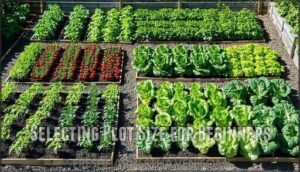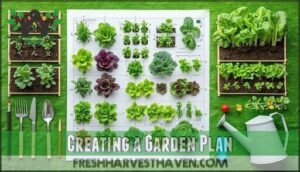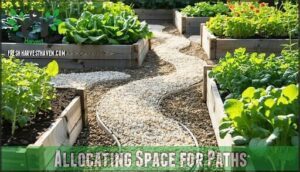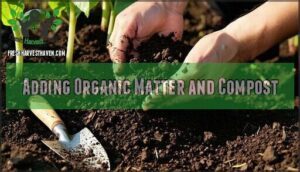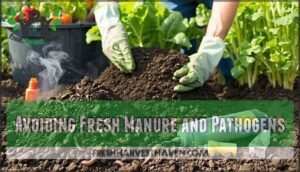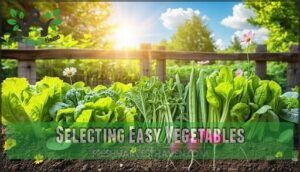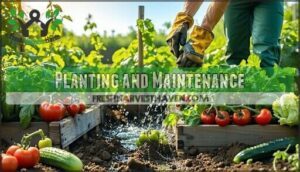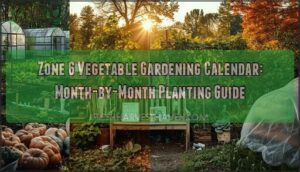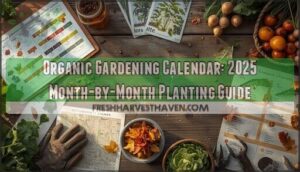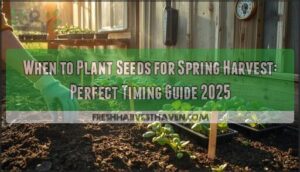This site is supported by our readers. We may earn a commission, at no cost to you, if you purchase through links.
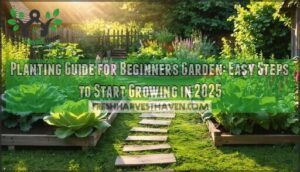
Keep your garden small and easy to manage, marking clear paths so you don’t step on your crops. Mix in compost to boost your soil, but skip fresh manure to avoid harmful germs.
Choose hardy veggies like lettuce, radishes, or bush beans, and plant what your family eats. Water regularly, watch for pests, and use supports for climbers.
Stagger plantings for a longer harvest—and there’s a clever trick ahead!
Table Of Contents
- Key Takeaways
- Choosing Garden Location
- Garden Size and Layout
- Preparing Garden Soil
- Selecting Easy Vegetables
- Planting and Maintenance
- Frequently Asked Questions (FAQs)
- How do I start gardening as a beginner?
- How to get started with gardening?
- Should you ask for gardening advice for beginners?
- How do I start a vegetable garden?
- How do you plant a garden?
- How do I start my gardening journey?
- How to garden for beginners step by step?
- In what order should a garden be planted?
- What is the most common mistake of first time gardeners?
- What is the 3-hour rule for gardening?
- Conclusion
Key Takeaways
- Pick a sunny, well-drained spot and keep your first garden small to stay on top of maintenance.
- Prep your soil by mixing in compost and avoid using fresh manure to protect your plants.
- Choose easy veggies like lettuce and radishes, and plant what your family actually likes to eat.
- Stagger your plantings every couple weeks for a longer, more manageable harvest.
Choosing Garden Location
When you choose your garden location, look for a spot that gets at least six hours of direct sunlight, drains well, and is protected from strong winds and heavy foot traffic.
Picking the right area helps your plants grow strong and healthy, making your gardening experience more successful and manageable.
A well-chosen garden spot sets the stage for vibrant, thriving plants and a stress-free gardening journey.
Assessing Sunlight Requirements
Think of sunlight as your garden’s main ingredient—without enough, plants can’t thrive.
Before choosing a location, track Sunlight Duration across your yard, noting how Seasonal Changes affect light patterns and Microclimates. Some spots reflect more light, boosting growth.
Here’s how to spot the best garden spot:
- Full sun: 6-8 hours, great for tomatoes and peppers.
- Partial shade: 3-6 hours, suits leafy greens and herbs.
- Shade tolerance: Match plant needs to available sunlight.
Ensuring Good Soil Drainage
After checking your sunlight, it’s time to focus on soil drainage—your garden’s lifeline.
Grab a shovel and try Drainage Testing: dig a hole about a foot deep, fill it with water, and see if it drains within 30–60 minutes.
If water lingers, you risk waterlogging and unhappy roots.
Clay-heavy Soil Composition traps moisture, while sandy soil drains too fast.
The best soil for garden beds is loose and loamy.
Improve soil preparation by adding organic matter—compost or aged manure—as soil amendments.
For stubborn spots, Raised Beds offer Waterlogging Prevention and better drainage, keeping your plants’ roots healthy and thriving, with the help of soil amendments and proper Drainage Testing.
Protecting From Wind and Foot Traffic
Once your soil drains well, it’s time to shield your planting beds from gusty winds and busy feet.
Use Windbreak Options like dense shrubs or low fences for added shelter. Fencing Solutions and Plant Barriers double as wildlife protection and keep pets out.
For Pathway Design, mark clear walkways with sturdy Garden Edging, ensuring enough Plant Spacing.
These beginner gardening tips help maintain your garden layout and prevent accidental trampling of young plants.
Consider climate appropriate fruits for ideal growth, using Fencing Solutions and focusing on Garden Edging.
Garden Size and Layout
When planning your garden size and layout, you’ll want to match the plot to your available space, time, and resources, making sure it’s easy to manage and fits your goals.
Careful layout with clear paths, proper plant spacing, and access to water helps your garden stay organized and productive from the start.
Selecting Plot Size for Beginners
A 10×10-foot patch is a sweet spot for most beginners garden plans—big enough for a few veggies, small enough to manage.
Weigh Space vs Yield, your Time Commitment, Budget Constraints, and any Physical Limitations.
Leave room for Future Expansion if you catch the gardening bug.
This beginner gardening tip makes starting a garden less overwhelming and more rewarding.
Creating a Garden Plan
Once you’ve picked your plot size, it’s time to sketch your garden design.
Use layout tools or graph paper to plan where each plant goes.
Consider these five steps:
- Define your garden goals and budget.
- Map sunlight patterns.
- Plan crop rotation.
- Use companion planting.
- Schedule succession planting.
Efficient garden planning leads to healthier plants and easier maintenance, which is the key to a successful garden with easier maintenance.
Allocating Space for Paths
As you move from garden planning to garden layout, don’t overlook path width and accessibility needs.
Leave at least 18–24 inches for easy movement and maintenance access. Choose a material like gravel or wood chips for simple upkeep.
Smart path design in small space gardening keeps every bed reachable, making garden accessibility and overall garden design both practical and attractive.
Consider square foot gardening methods to maximize space and efficiency.
Preparing Garden Soil
To get your garden off to a strong start, you’ll need to prepare the soil by loosening it and mixing in organic matter like compost.
This step improves drainage, boosts nutrients, and gives your plants the best chance to grow healthy roots.
Adding Organic Matter and Compost
Once you’ve mapped out your garden’s layout, it’s time to enrich your soil with organic matter.
Mixing in compost boosts soil health, supports soil microbes, and improves soil structure. Try different compost types and composting methods to see what works best.
Boost your garden’s vitality with compost—feed the soil, nurture microbes, and watch stronger plants thrive.
Regular composting encourages nutrient cycling, which plants love. Consider garden compost options for ideal soil enrichment.
Always start with a soil test before soil preparation for best results, ensuring you make the most of your soil preparation efforts.
Avoiding Fresh Manure and Pathogens
Handling manure in your garden? Skip using it fresh—pathogen risks lurk there. Instead, focus on composting manure, which transforms it into a safe alternative for enriching organic matter.
Remember that optimal pH levels are essential for nutrient absorption. Always prioritize soil testing and good hygiene practices when preparing your beds.
These organic gardening basics help keep your soil healthy and your veggies thriving. Key considerations include:
- Composting Manure
- Soil Test
- Hygiene Practices
- Safe Alternatives
Selecting Easy Vegetables
When you’re ready to choose vegetables for your new garden, focus on varieties known for being easy to grow, such as lettuce, radishes, and green beans.
Selecting crops suited to your climate, sunlight, and soil will help you achieve reliable growth with less effort and fewer problems.
Beginner-Friendly Vegetable Options
Starting out, it’s best to dig into Low-Maintenance Veggies like lettuce, radishes, and bush beans—these easy vegetables to grow suit all garden types.
Consider Space Requirements and Climate Considerations, too. Sow seeds directly or try seedlings if you’re anxious for results.
Here’s a quick glance:
| Veggie | What Makes It Easy |
|---|---|
| Lettuce | Fast, shade-tolerant |
| Radishes | Quick, low fuss |
| Bush Beans | No staking, strong yields |
Choosing Herbs for Low Maintenance
A windowsill lineup of Perennial Herbs—like thyme and sage—makes garden maintenance straightforward for beginner gardening.
Choose herbs with proven Drought Tolerance and pest resistance, then match Soil Needs to your site and get ready for tasty Culinary Uses year-round.
Proper watering prevents overwatering and underwatering and guarantees healthy growth.
Here’s how to set yourself up for success:
- Select pest-resistant varieties
- Prioritize drought-tolerant herbs
- Try Companion Planting for easy vegetables to grow
Considering Family Preferences and Consumption
Choosing vegetables for your garden starts with knowing what your family actually eats.
Let everyone pick a plant—kids included—for true Kid-Friendly Veggies and Waste Reduction.
Select crops that fit your Dietary Needs and suit your favorite recipes for smooth Recipe Integration.
Quick-maturing picks like radishes add fast wins.
Use the table below to compare options and match your vegetable garden to family habits, whether you’re working with seedlings or direct transplants.
| Crop | Family Favorite? |
|---|---|
| Radishes | ✓ |
| Tomatoes | ✓ |
| Peppers | |
| Lettuce | ✓ |
| Turnips |
Planting and Maintenance
You’ll need to plant each vegetable at the right time and keep a close eye on watering, pests, and plant support for healthy growth.
By staying on top of these steps, your garden will produce steady harvests and stay strong throughout the season.
Planting at The Right Time
You’ve picked your veggies, so let’s talk timing.
Use a planting guide to know when to start seeds indoors or move seedlings outside, and keep an eye on frost dates and local plant hardiness zones.
Seasonal planting matters—cool crops like lettuce go in early, while tomatoes need warmth.
Understanding planting seasons is essential for maximum growth and yield.
Maximize success with:
- Succession planting tricks
- Checking regional variations
- Tracking climate considerations
Watering and Irrigation Systems
Timing is everything—watering frequency depends on weather, soil moisture, and plant needs.
Using the right irrigation types, from soaker hoses to automated systems, helps with water conservation and keeps your garden healthy.
Drip irrigation shines for garden irrigation, delivering steady water where it counts.
Many gardeners find complete drip irrigation systems efficient and easy to install.
Explore this quick comparison:
| Watering Technique | Water Sources | Conservation Level |
|---|---|---|
| Hand Watering | Hose, Rain Barrel | Low |
| Soaker Hose | Spigot, Timer | Medium |
| Drip Irrigation | Reservoir, Timer | High |
Managing Pests and Diseases
With every garden, pests and diseases are bound to show up. Get ahead by identifying pests early and practicing disease prevention.
Here’s a three-step game plan for pest management:
- Use organic pesticides sparingly.
- Attract beneficial insects through crop rotation and mixed planting.
- Monitor regularly, pulling weeds and checking for common garden pests to stop garden diseases before they spread.
To maintain a healthy garden, consider how ecosystem balance can minimize pest impact and support ecosystem balance.
Providing Support for Climbing Plants
If pesky bugs and diseases are no longer an issue, it’s time to give your vining garden plants some much-needed support.
Tall crops like beans, peas, and cucumbers all benefit from sturdy vertical structures, choose your Trellis Selection wisely—wooden stakes, bamboo, or even a natural support like twisted branches work well.
Start staking methods or set up trellises before you plant to avoid root disruption, gentle plant training, using soft ties, keeps stems secure.
Regular pruning and proper plant care keep climbers tidy, making plant support a key garden tip in gardening for beginners.
Staggering Plantings for Continuous Harvest
Succession planting is the secret to a steady, manageable harvest in your vegetable garden.
Instead of sowing everything at once, plant key crops—like lettuce—in two-week intervals.
This planting technique, combined with variety selection and crop rotation, brings season extension and harvest extension within reach.
You’ll avoid overwhelming gluts and keep your garden productive.
With succession planting, you’ll use planting intervals and rotation to guarantee continuous crops, making your effort pay off every week.
Frequently Asked Questions (FAQs)
How do I start gardening as a beginner?
You don’t need a green thumb the size of Texas to start.
Pick a sunny spot, test your soil, add compost, choose easy plants, and water often.
Starting small lets you learn and avoid overwhelm early on.
How to get started with gardening?
Pick a small, sunny spot with easy access to water.
Clear weeds, loosen the soil, and add compost.
Choose easy plants like lettuce.
Water regularly, watch for pests, and keep learning as your garden grows alongside you.
Should you ask for gardening advice for beginners?
Absolutely, you should ask for gardening advice as a beginner.
Even the greenest thumb started somewhere, and tapping into others’ experience saves time, prevents common mistakes, and gives you confidence to grow your first healthy plants.
How do I start a vegetable garden?
Did you know nearly 35% of homegrown veggies come from small backyard plots?
Start your garden with loose, rich soil, at least six hours of sunlight, good drainage, easy water access, and plants that match your climate’s rhythm.
How do you plant a garden?
Start by choosing a sunny spot with good soil, loosen it with a shovel, and mix in compost.
Plant seeds or seedlings following spacing instructions, water gently, and keep an eye out for weeds or pests as things grow.
How do I start my gardening journey?
Survey your space for sunlight and water access, then choose easy-to-grow plants that fit your climate.
Loosen soil, add compost, and map out your garden, keeping your goals and available time in mind for steady growth.
How to garden for beginners step by step?
Like planting seeds of knowledge, gardening’s your gateway to green-thumb mastery.
Choose a sunny location, test soil, select beginner-friendly vegetables like lettuce and tomatoes.
Prepare beds with compost, plant according to spacing guidelines, water consistently, to ensure the growth of your selected vegetables, such as lettuce and tomatoes.
In what order should a garden be planted?
Plant cool-season crops like lettuce and radishes first in early spring, then warm-season vegetables like tomatoes and peppers after the last frost date passes.
What is the most common mistake of first time gardeners?
Over 70% of new gardeners plant too much too soon.
You’re likely overplanting your space, leading to overcrowded beds where plants compete for nutrients and sunlight, making maintenance overwhelming and reducing yields.
What is the 3-hour rule for gardening?
The 3-hour rule suggests you should limit gardening sessions to three hours maximum to prevent overexertion and maintain enjoyment.
This helps you pace yourself, avoid burnout, and keep gardening sustainable long-term.
Conclusion
Remember that clever trick we mentioned? Here’s the secret: succession planting.
Plant the same crops every two weeks to avoid harvesting everything at once.
Starting your planting guide for beginners garden doesn’t require perfection, just patience and practice.
Your first garden will teach you more than any book ever could.
Make mistakes, learn from them, and celebrate every tomato that ripens on your vine.
- https://www.gardenary.com/blog/gardening-for-beginners-4-steps-to-get-started
- https://hort.extension.wisc.edu/articles/beginning-vegetable-garden-basics-site-selection-and-soil-preparation/
- https://www.fbfs.com/learning-center/how-to-start-a-garden-a-beginners-guide
- https://cultivate.caes.uga.edu/guide-to-healthy-garden-soil/
- https://www.reddit.com/r/gardening/comments/2sxrfs/good_vegetables_to_grow_for_beginners/

